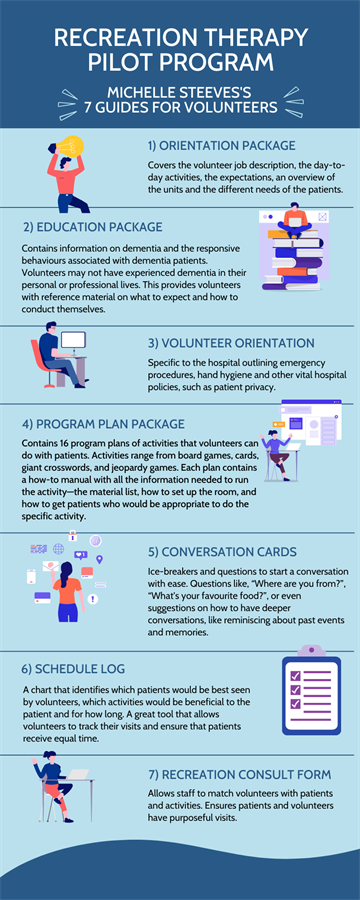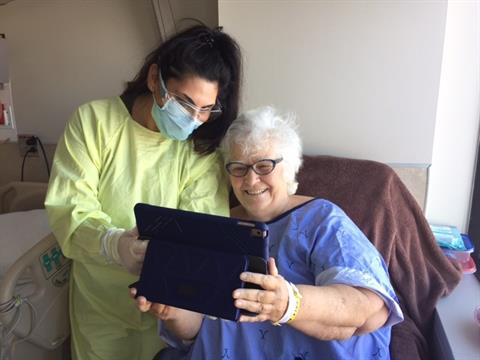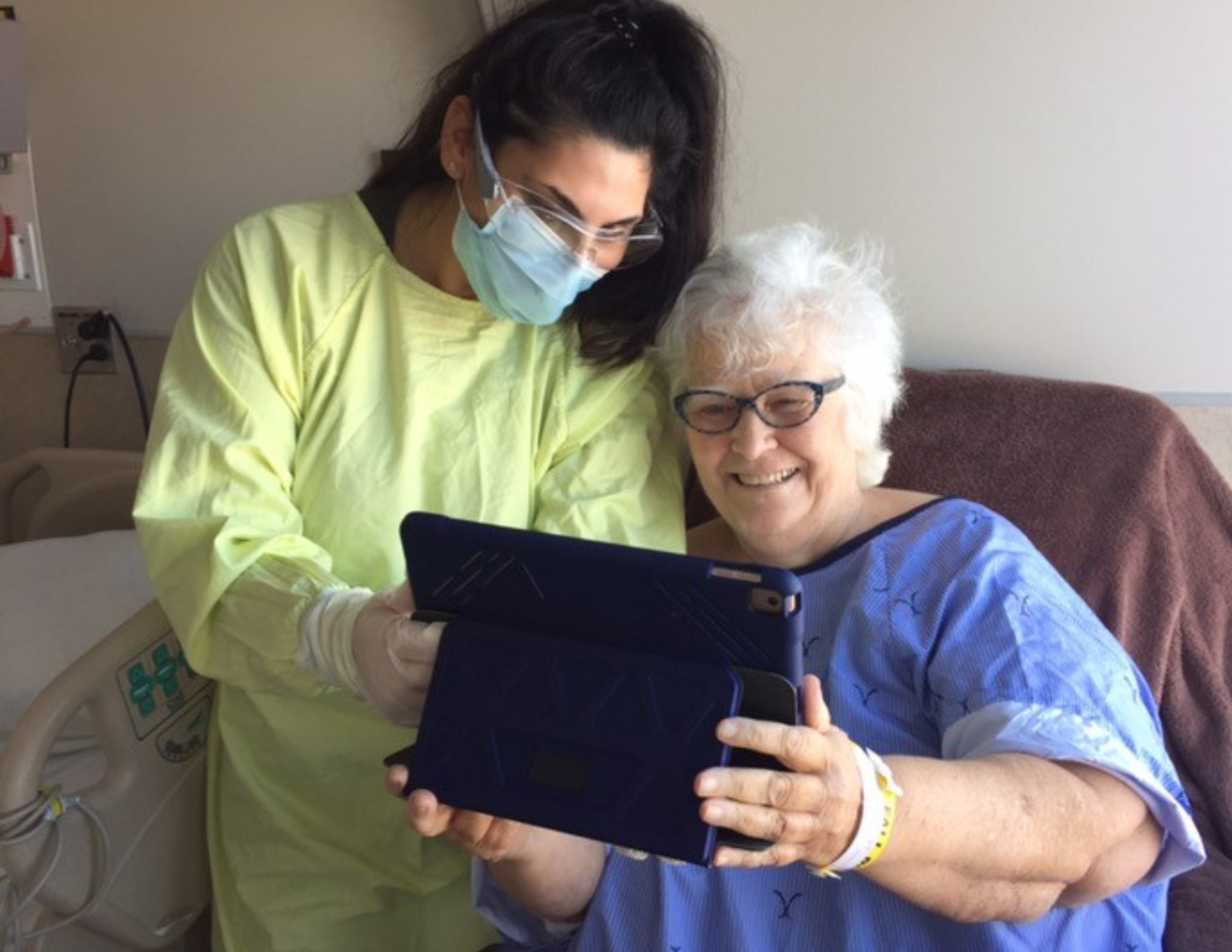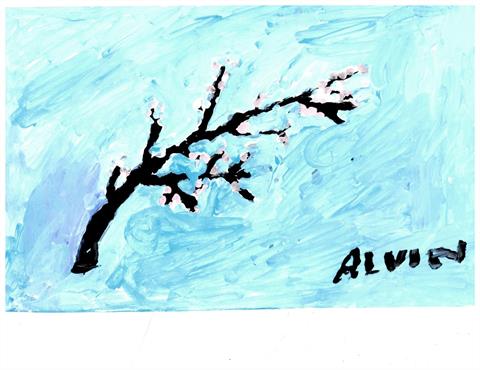Thanks to the generous donations from our community, we invested in the creation of a Recreation Therapy Pilot Program that fundamentally impacted the health and wellness of patients with dementia on Low-Acuity Units at Victoria Hospital and connected them to loved ones, near and far.
Research shows that hospital environments that support mental and social health along with physical health result in more positive outcomes for patients. Over the last two years, the COVID-19 pandemic laid bare the impacts many patients and their families experienced while hospital staff and caregivers nation-wide strived to balance mental and social needs with the demands of keeping patients safe and healthy.
Thanks to our donors’ generosity, Victoria Hospital Foundation invested in Manitoba’s first Recreation Therapy Program for low-acuity patients. This investment allowed two Recreation Therapists, Michelle Steeves and Kristen Jabbour, to implement a full program of recreation activities that improved the quality of life for patients living with dementia and memory care needs. These activities also resulted in positive outcomes for families and staff, such as decreased stress levels and improved well-being.
Why A Recreation Therapy Program Is Important
“The Recreation Therapy Program was a two-year pilot project with the goal of developing a full roster of programs specifically for patients on our low-acuity units (4 North, 5 North, and 5 South) and which could ultimately be run by volunteers,” recalls Jackie Reid, Manager of Patient Care, Victoria Hospital.
Reid explains that the grant was a catalyst for the implementation of recreation therapy services for inpatients who would benefit from recreational activities, interactions and stimulation while in hospital. These low-acuity patients are often older adults with dementia or memory care needs waiting to go home, into assisted living, live with family, or transition into a personal care home.
Patients living with dementia stay on average 42 days on these units and, prior to the pilot project, had limited programming. The Canadian Association for Long Term Care reports that recreation therapy enhances older-adult patient outcomes by improving social, cognitive, and physical conditions during their hospital stay.
Research also shows that recreational programming minimizes aggressive behavioural symptoms, especially in patients with dementia, and reduces falls with injury by 20 per cent. A 2009 study published in Geriatric Aging found that the behavioural symptoms often associated with dementia, such as aggression, wandering, screaming, and apathy, are primary sources of caregiver burden and that recreational physical activities help prevent these behavioural symptoms.
Research supports the need for a recreational therapy program at Victoria Hospital to provide low-acuity patients living with dementia a better quality of life and significantly reduce caregiver burden and stress.
The Recreation Therapy Program Outline
The Recreation Therapy Program grant funded the two-year pilot program that began in September 2019 and ran until September 2021. Michelle Steeves, the inaugural Recreation Therapist, started her role by discovering the needs. As the program was to transition into a volunteer-run initiative once the pilot project ended, she focused her efforts on this aspect.
This type of volunteer programming included one-to-one patient interactions, such as a small leisure group to play games or an activity promoting different types of social interactions. It also included one-to-one activities such as a visit, a leisure activity that the patient enjoyed, or simply talking with a patient.
“I wanted to make a robust orientation process for these volunteers to ensure they had the proper tools to be successful because it would be quite an independent volunteer program. I wanted to make sure that once I wasn't there in two years, the program would still be able to move forward,” says Steeves.
Steeves also created several manuals, packages, and forms to ensure the legacy of the program.
 About six months after Steeves completed these preliminary steps, recruited volunteers, and started spending time with patients, COVID-19 struck and with it brought a list of restrictions and safety measures to keep patients safe and healthy.
About six months after Steeves completed these preliminary steps, recruited volunteers, and started spending time with patients, COVID-19 struck and with it brought a list of restrictions and safety measures to keep patients safe and healthy.
These new procedures presented numerous novel challenges to the program, which made Steeves pivot and find ways to turn lemons into lemonade, creating unexpected ways to connect with patients, families, and caregivers.
Connecting With Patients And Families During COVID-19
So how did Steeves create meaningful ways for patients to engage in activities that relieved behavioural symptoms and improved their well being when patients were not allowed visitors or anything brought in for them?
Steeves added a Virtual Visit Program, among other initiatives, to her roster of activities. The Virtual Visit Program, made possible by the generosity of our supporters, allowed the Foundation to fund the purchase of iPads that were used to make video calls. Without realizing the enormous impact the Virtual Visits would have, she started booking unlimited virtual calls. But as the word spread, calls had to be limited to 15-minutes in order to keep up with the high demand. The nursing staff communicated with families, and soon every single patient with family or even a friend wanted a visit.
“The Virtual Visits continued all through COVID. It was extremely busy, especially when volunteers or visitors were not allowed in the hospital, and loved ones were not allowed to come in to support in any capacity. I was probably booking 50 visits per week,” says Steeves.
Between the three low-acuity units, Steeves went from room to room doing virtual visits from 8 a.m. to 4 p.m. every day with only a short lunch break for herself.
The grant also allowed Steeves to order a variety of independent leisure activities such as media, radios, cards, books, word search, and colouring books. When volunteers were not allowed in the hospital due to COVID-19 restrictions, she would take this mobile activity cart around to patients on all three units. The activity cart made a tremendous impact on patients because it allowed them to participate in activities even when their families were not allowed to bring anything into the hospital.
In the latter half of 2020, Michelle Steeves accepted a Recreation Therapist role within Victoria Hospital’s Mental Health units. Soon after her departure, Kristen Jabbour took over the reins as Recreation Therapist. Jabbour continued the Virtual Visits and brought in more hands-on items such as drums and a piano, which was already on the unit, and someone would come in to play on the weekends. These new tools created the opportunity for more and different programming. Near the end of the two-year program, volunteers were allowed back on the units to visit and engage patients with activities.

Kristen Jabbour uses an iPad to connect a patient with her family during a Virtual Visit video call.
Jabbour spent countless hours with patients who were mobile and at risk of wandering the halls or into patient rooms. She engaged with them in activities and sensory tools and really kept them safe while improving their well-being.
Another activity that Jabbour and the volunteers organized were tea parties. These were a big hit! There would be cookies, tea, juice, or whatever foods suited their specific diet, and patients were encouraged to share stories and photos of their lives which stimulated conversation. Considering the average age of the patients was between 80 to 90 years, there were lots of stories to be told!
Impacts Of The Program
The impacts of the Recreation Therapy Program were huge. In fact, “they were immeasurable,” says Reid.
Reid continues, “You could see that it was making a difference, especially in patients with late-stage dementia—in a smile, colouring, or walking hand-in-hand with a volunteer. During those brief moments, you could see that they had a recognition and that something was pleasing.”
Steeves says that thousands of patients were seen by Recreation during the span of two years. During this period, there was a significant decrease in code whites and in patient's behaviour responses. There were also decreases in social isolation and boredom because the activities and social interactions engaged the patient’s mental and social needs. The program also had a significant impact on family and caregivers. Especially during COVID-19, the Virtual Visits took away a lot of stress and anxiety for family members. When family members could not see their mom, dad, sister, brother, wife, or husband, the Virtual Visits were sometimes the only form of communication, especially for older adults who were not capable of using a cell phone.
Steeves recounts one virtual call she had with a patient who was experiencing mobility issues and her daughter. “We were able to help the patient gain her independence, and her daughter could not believe what she was seeing!” Steeves remembers walking and holding the iPad with the physiotherapist and showing the daughter how well her mom was doing; and the daughter was just so amazed!
Without the iPads and Steeves or Jabbour being there, these connections would not have been possible. These iPads even helped staff communicate with family members because nurses could jump on the video calls and give a quick update.
The video calls made communication easier. After every single call, many family members said, “Thank you so much for calling, I feel so much better.” Whether the family member lived in Winnipeg or another province, they could connect and see their loved ones—all because of this program.
Reid also received a wonderful gift from a patient who used to be an artist. One day he came into her office and said, “Hey, I made you something today,” and he handed her his signed painting. Reid was so touched that she hung it in her office, and later when the patient’s sister saw it, she said, “Hey did my brother make that for you?” After Reid replied, “Yes, he did,” she joked, “Well, he never made anything like that for me!”
Families Show Their Gratitude
Steeves received multiple thank you cards and witnessed family members in tears when their loved ones were being discharged to a personal care home because they knew they may not have as many Virtual Visits anymore. In the hospital they were able to see their loved ones every day, but in a personal care home, the service may be limited due to technology or staffing. Steeves says, “It was interesting to see family members sad that their loved one was leaving the hospital, because normally, that is not the case.”
One message summed up the gratitude expressed by many of the families touched by the program:
“I wanted to pass on my gratitude for the FaceTime video calls I have been able to have with my mother over the last few days. I have been heartsick being unable to visit mom and travel to Manitoba with the COVID-19 restrictions.
I am relieved and thankful that you have the technology to be able to facilitate this kind of communication between a patient and family. It was such an amazing surprise to be able to talk to mom, as I’ve been able to do these last few days. It gives me such peace of mind and the sense that I’m actually able to be there with my mom and support her through this difficult time. I can clearly see on her face that the calls are equally as important to her.
Words do not adequately express my gratitude and thanks. I know how beneficial it is for me, and I’m sure there are many other patients and families that will also experience the benefits when situations result in them being unable to be together physically.
Thank you again. - Family member from Saskatchewan
How You Make A Difference
The difference this program has made in the lives of those in need and their loved ones was insurmountable. And this is all thanks to you, our supporters!
Thanks to your generosity, our Foundation invested in this important program to help Victoria Hospital improve the quality of life for patients living with dementia.
Steeves says that without the funding, she would not have been able to be there in any capacity, and she was grateful to have a budget to purchase equipment and materials. “In Recreation, you can only do so much without materials—you need games, independent leisure activities, and items like colouring books, word searches, books, and pencil crayons, all need to be replaced. Materials are the tools that make the program thrive, and without them, I can only talk to patients.”
______________________________________________________________________
Would you like to help make a difference in our community? Consider donating to Victoria Hospital Foundation to support the care of older adults at Victoria Hospital or become a volunteer with the Victoria Hospital.




